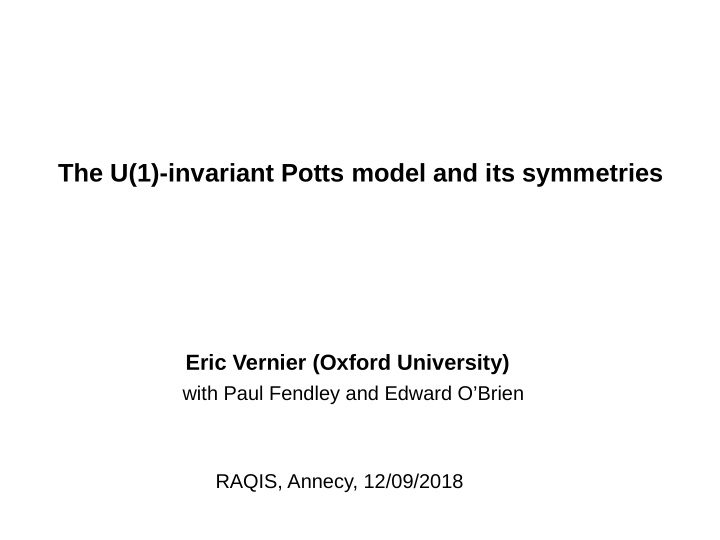



The U(1)-invariant Potts model and its symmetries Eric Vernier (Oxford University) with Paul Fendley and Edward O’Brien RAQIS, Annecy, 12/09/2018
Background: degeneracies at root of unity XXZ Hamiltionian Bethe equations : Degeneracies between states of magnetizations These are due to exact n-strings : Fabricius McCoy‘01 zero energy do not change BAE for other roots “0/0 solutions” (even though, the original BAE are really 0=0) Deguchi Fabricius McCoy‘01 Algebraic structure behind this : loop algebra
Some questions : → are exact n-strings quantized ? Fabricius McCoy‘01, Baxter ‘02 → do they have some more physics ? (do they play the role of quasiparticles for another Hamiltonian?) → implications for CFT ? To investigate this, we will look at a seemingly different model
The U(1)-invariant Potts model Self-dual quantum chain : Duality : We look for a new model which preserves nearest-neighbour interaction and self-duality , but in addition has U(1)-invariance Conserved U(1) :
Coordinate Bethe ansatz Because of U(1)-invariance, we can try CBA (for illustration ) etc...
Reparametrization : Same as spin-1 XXZ chain at Fateev Zamolodchikov’ 80 And indeed, the Hamiltonians coincide ! In spin language : → Degeneracies due to exact 3-strings → continuum limit: antiferro: c=3/2 superCFT Alcaraz Martins ‘89 ferro: c=1 boson Baranowski Rittenberg ‘90 →generally, n-state U(1) Potts = spin- XXZ at
So far so good, but we haven’t learned much new about (higher spin) XXZ Now, we will use the U(1) Potts formulation to access some interesting new (or not so new) features : 1. Onsager algebra symmetry 2. “chiral decomposition”
Onsager symmetry A simple observation to start with self-dual and commutes with , so it should also commute with the dual of ! U(1)-neutral changes Q by -n changes Q by +n For n=3, Easy to check that in fact,
2nd observation : Dolan-Grady relations Dolan Grady’ 82 Therefore, generate the Onsager algebra (algebra of fermion bilinears) Onsager ‘44, Davies’ 90 Duality : Conclusions : → so Onsager related to degeneracies already noticed in XXZ from loop algebra : Deguchi Fabricius McCoy‘01 Nishino Deguchi ‘06 → connection with superintegrable Chiral Potts : von Gehlen Rittenberg ‘85, Albertini McCoy Perk Tang ‘89
Chiral decomposition Originally (before noticing the spin-1 correspondence) we were wondering whether we could deform H into something chiral, but still integrable.
Chiral decomposition (n=3 for the example) Originally (before noticing the spin-1 correspondence) we were wondering whether we could deform H into something chiral, but still integrable. the answer is yes: (for periodic bc) → are purely left (right) moving → energy of 1 particle : → energy of one exact 3-string : so lift the degeneracies due to exact 3-strings therefore exact 3-strings should be quantized through CBA for (or ) → relation with Onsager :
Coordinate Bethe ansatz for → Ordinary particles satisfy the same BAE as for the full → But in addition we find a quantization for the exact 3-strings: characterizes the exact 3-string scattering with ordinary particles Exact 3-strings do not feel one another , only through some exclusion principle eg: in the absence of ordinary particles, they are quantized by the solutions of In terms of Chebyshev polynomials : Remarks : → not the same quantization as that of Fabricius McCoy‘01, obtained from a limit (but the latter is unrelated with ) → Crampé Frappat Ragoucy ‘13 study 3-states models solvable by CBA, but it looks like are not directly related to their classification
Spectrum of the family spin 1 spin 1 ferro, c=1 antiferro, c=3/2 ground state = L (1-)-strings ground state = L/2 2-strings ground state = L/3 exact 3-strings
To finish : Can we fit all that into a quantum group construction ?
Quantum group construction I (once again n=3 for illustration) The XXZ spin-1 Hamiltonian is generated by a family of transfer matrices: are the spin-1 generators on the auxiliary space Now, at , there are other 3-dimensional representations one can put on the aux space : spin-1 nilpotent semicyclic cyclic This fact has been used in the last few years by the quench community to construct conserved quasilocal charges Prosen, Ilievski, Medenjak, Zadnik ‘13, ‘14, ‘15 But it has remained apparently unnoticed that one can also build local charges
Quantum group construction II : the chiral Hamiltonians Focus on the nilpotent representations : 2 parameters (spectral parameter), and → new parameters → we consider the transfer matrix at . It is generated by : Lower triangular, so purely right-moving ! and indeed, → TQ equation De Luca, Collura, De Nardis ‘17 → From there we can rederive the quantization of exact 3-strings !
Quantum group construction III : (semi)cyclic reps do not commute with one another, but they do commute with the fundamental , and therefore with From there we can construct conserved charges which change Q by . Eg : Onsager generators ! However it is not yet clear which precise scheme connects the to the successive derivatives of the TM
Conclusions → U(1) invariant Potts models = spin- XXZ at → chiral structure Gives energy to the exact n-strings, lifts degeneracies → all of this hidden in quantum group auxiliary representations Perspectives & aspects I didn’t have time to tell about : → Implications for the continuum limit (symmetries of CFT characters) → Onsager generators in the CFT ? Hagendorf ‘17 Bernard Pasquier ’ 89 → supersymmetry of the n=3 chain → Physics of the model ? → Phase diagram of the 1 parameter Potts/U(1) Potts model [to appear]
Thank you for your attention !
Recommend
More recommend